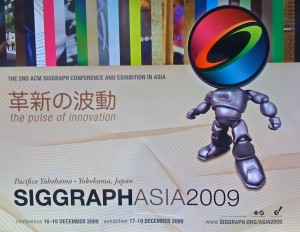After seeing the papers and Electronic Theatre – we turn our attention to the serious courses and classes. Plus, we’ve got to catch up with senior members of the gaming and film industry, including Rob Cook from Pixar.
Friday
Masterclasses, Talks and Courses
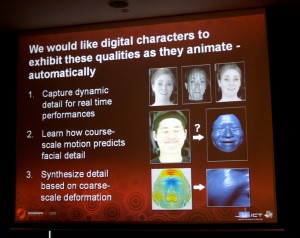
First thing on Friday morning was a great paper from Paul Debevec. If you are a regular reader of fxguide you will know that we were very excited by the very high resolution facial scans that Paul Debevec and his team showed at Siggraph LA. This paper built on this in an interesting way. The LA work allowed for an actor to be sampled in a light stage with a variety of expressions and the resulting data was not only extremely high resolution but it separated specular and diffuse components of the skin. The downside was the restriction of needing the actor to ‘act’ in the lightstage and in isolation from other actors.
The Singapore work proposed a workable system of using a normal large motion capture stage – with current facial markers, and then combining this with a secondary offline high res sample. The theory is that the actor is sampled in the Lightstage with a new video camera, but with the resulting high quality facial accuracy that so excited the community in LA.
On the traditional motion capture stage the data is not used directly for the face, but rather it drives a secondary system that provides much higher quality facial animation. It does so by interpolating the data from the course sampling sound stage data to the much much higher resolution Lightstage data. This results in the actors being able to move and act with other actors and props on the capture stage with unbelievably accurate facial animation down to the skin pore level.
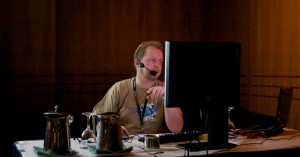
While Technical Papers may be the backbone of the conference, for many people the courses are a unique chance to catch up on the latest research and have a master class style session on a specific topic. These courses can be a brilliant chance to get worldclass information without having to interpret the research papers into the broader body of work on a subject.
We attended some excellent courses, one that stood out was Zap Andersson’s course on Mental Ray shaders, sponsored by Autodesk.
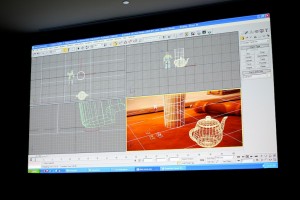
Zap’s Mental Ray course covered:
– Gamma & Linearity – how to work in true linear space for more accurate lighting and compositing results.
– Mirror Balls and Rendering – how to use a single mirror ball shot – from the direction of the camera to provide a wealth of lighting and shadowing information in combination with Mental Images production shaders.
– Global Illumination’s use in Animation. Often GI works great for stills but for moving images Final Gathering (FG) can have issues; either the FG can bog down or worse produce ‘popping’ textures. Zap showed a great method allowing for full GI ‘sky and sun’ animation, as recently used in the Warhammer cinematic done by Blur studios.
– Tips for saving memory, and rendering tips for huge scenes. Most tips were Max orientated but others were common to all packages – such as the use of ambient occlusion and the tendency to “smack it on top… it should occlude AMBIENT light – on Indirect illumination and not over reflections and everything else.”
Rob Cook Keynote
After Lunch Rob Cook of Pixar gave a keynote speech on the process of making a Pixar animated film, giving the audience a chance to hear some of the behind the scenes approaches Pixar takes to its award winning animations. Cook used examples from the whole range of Pixar films to show pitch meetings, storyboarding, character development, animation and rendering. The talk was clearly a huge winner with the packed lecture theatre. While the speeches from Siggraph are not on line, fxguide has an exclusive Rob Cook podcast scheduled for the beginning of January in which Rob discusses the early days of Pixar and focuses on the technical achievements of the company.
Saturday
Training
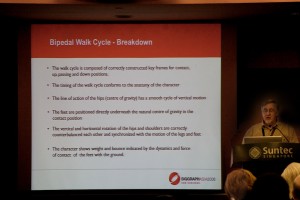
The conference, in general, catered very well to educators. For example, in a special educational forum session IDD’s Robin King gave a very impressive discussion of their work in developing not only courseware and running animation courses but also in defining a standard for animation education called Exit Competencies. The idea is that we should, as an industry, be able to define what you need to know in an area such as say animation. This would include, for example, being able to do a walk cycle – and further, an acceptable walk cycle should be able to be defined.
If we could define the range of things a graduate should be able to do, it would not only help employers but also educators in making sure they have courses to teach these things. Even students would welcome knowing what might be expected from them at a facility if they applied for a specific job. It sounds simple but at the moment there is not even a vague standard of what say a roto/paint student should be comfortable with when they finish a course. Without this, employers can find annoyingly large variations in actual skills of new recruits.
Michael Sehgal, Education Programs Manager Media & Entertainment Division of Autodesk, Inc. also launched some new Professional Excellence programs and flagged that the Autodesk AREA would be expanding to cover System Products this quarter. His presentation on the Key Elements of Professional Development was particularly insightful, explaining education as a range from Training & short term needs to longer term education and finally the most broad form of Professional Development which seeks to not just say “what do I do here?” – or “how do it do it?” but also “why do we approach this problem like this in the first place?” It is great to see companies committing serious thought to the global problems of continuing education.
Games

Siggraph cover more than just animations and films, and a very key part of the Siggraph audience was Gaming. With advances in gaming engines and the growth of truly inspiring game cinematics, games were at the forefront of Siggraph Asia. Nvida, Autodesk and others featured presentations at their booths on the state of the art in Gaming. Watch for an exclusive interview with TJ Galda from EA sports in coming weeks.
TJ Galda has an impressive list of feature film credits, but most recently he has headed a cross product special gaming unit that will be revealed next year which aims to include you the viewer in the game. fxguide sat down and discussed the state of the gaming industry with Galda and that will be in an upcoming fxpodcast.
Trade show
The trade show was naturally much smaller than the last Siggraph in LA, this conference had only about 3,000 attendees, approximately 1/10th of the size of Siggraph LA – which had some 28,500 attendees. In fairness, the tradeshow did not feel a 1/10th of the size of LA. Autodesk had once again the largest booth, but Lucasfilm and others had sizable ones. We spoke to some companies who had only small booths this year – with the common comment that they were just ‘testing the waters’ but several companies we spoke to such as Pixar suggested they may be expanding the size of the presence next year.
Job Fair and Posters
There are many parts of the Siggraph conference. Two areas were extremely small in comparison to the main Siggraph. The posters program was a fraction of the size of the American conference. The most disappointing aspect of the whole conference was perhaps the Job Fair. There really was a stark lack of employers looking for staff. The American conference is great for people seeking to meet recruiters but this is one area we would love to see expanded for next year. There were some companies with booths for recruiting but Siggraph Asia would be greatly improved if some way could be found to improve the job fair. Siggraph itself is not perhaps to blame for this however, coming as it did in the middle of the global economic crisis.
New technology
This is always one of the most unusual aspects of Siggraph, with a range of new and sometimes wacky technology and art pieces. In looking at some of the exhibitions such as a projected floor pattern that reacts as you walk over it, seem immediately applicable to commercial use for interactive in-store advertising, while others just stumped our ability to either understand or predict its future applications – yet alone its current artistic intent. The size of the exhibition was quite respectable and reflected the local Asian community more strongly than perhaps any of the other major categories of Siggraph events or technical content.
Next Year 2009 : Japan
The Next Siggraph is in New Orleans Aug 3rd through the 7th 2009
The Next Siggraph Asia is in Japan: Yokohama 17th – 19th of Dec 2009

